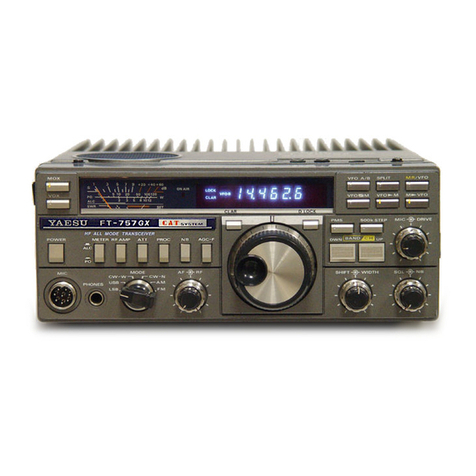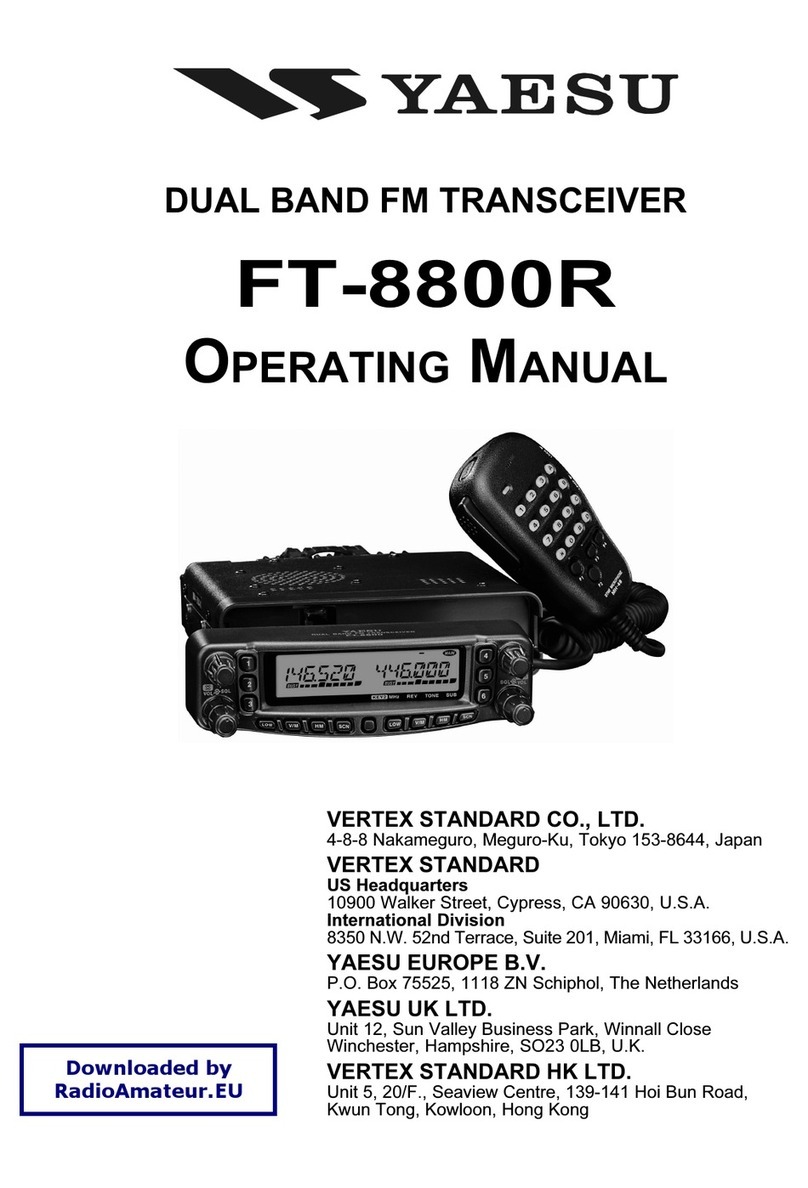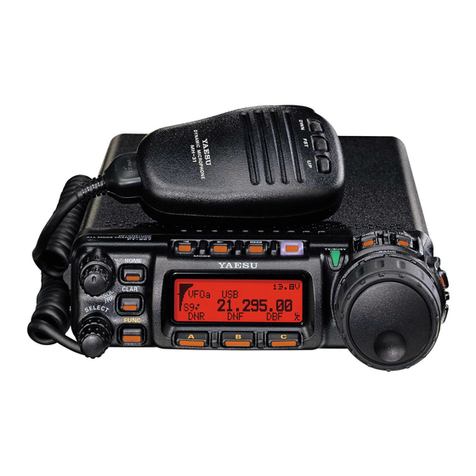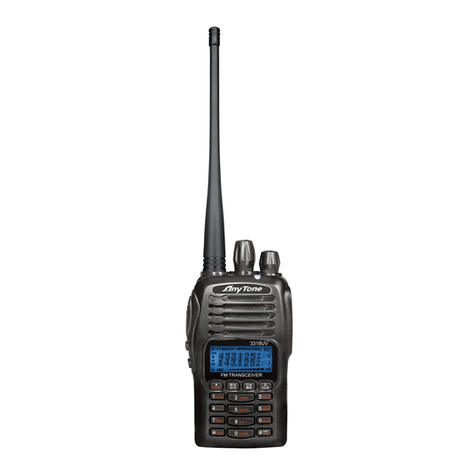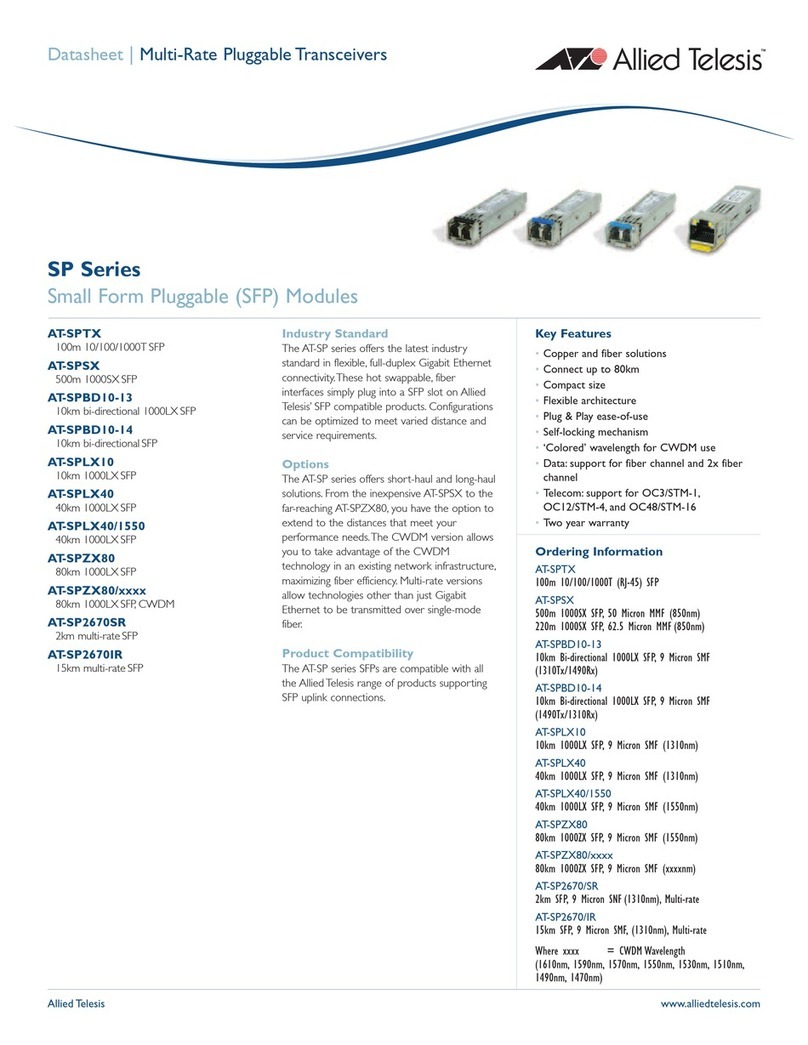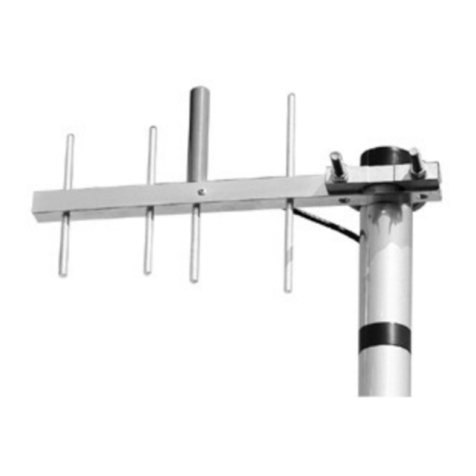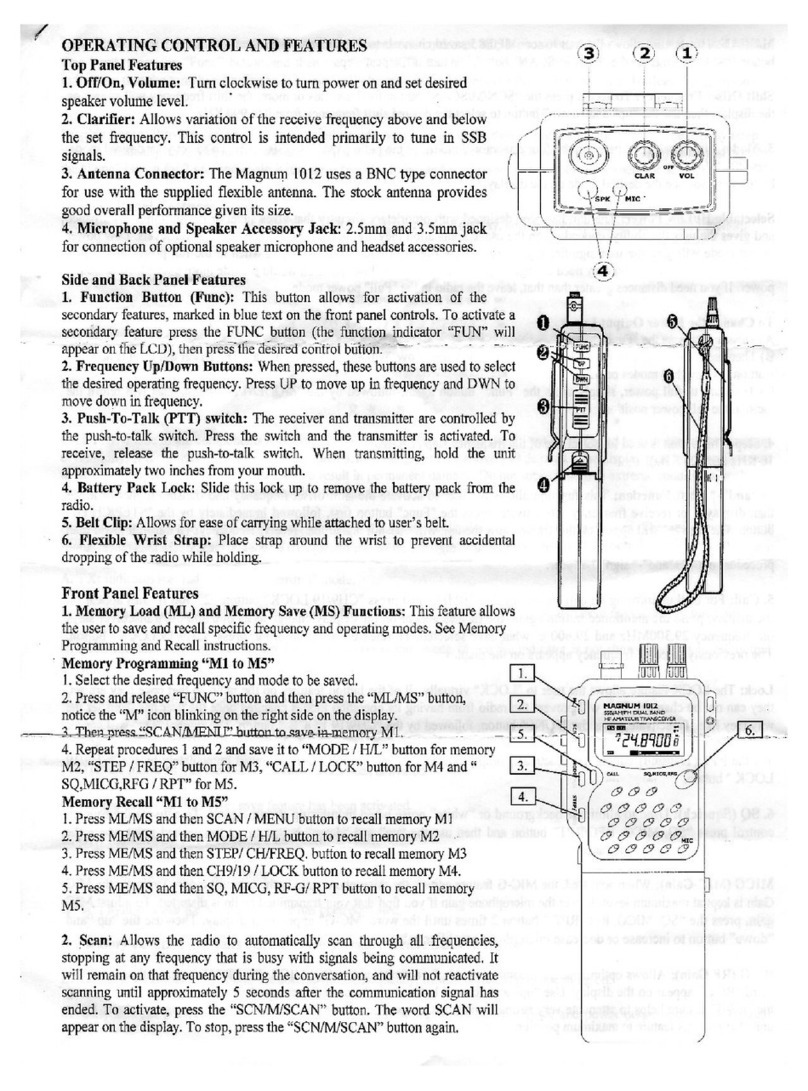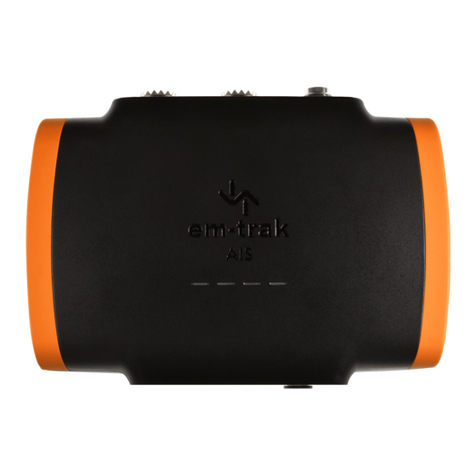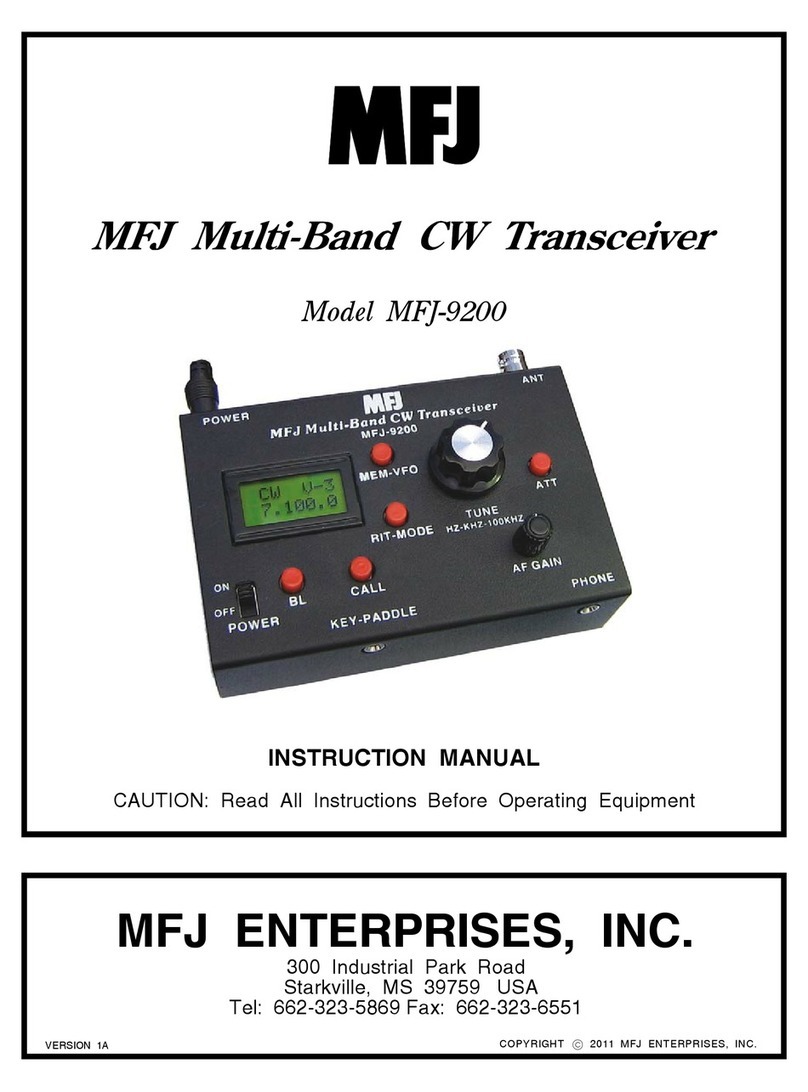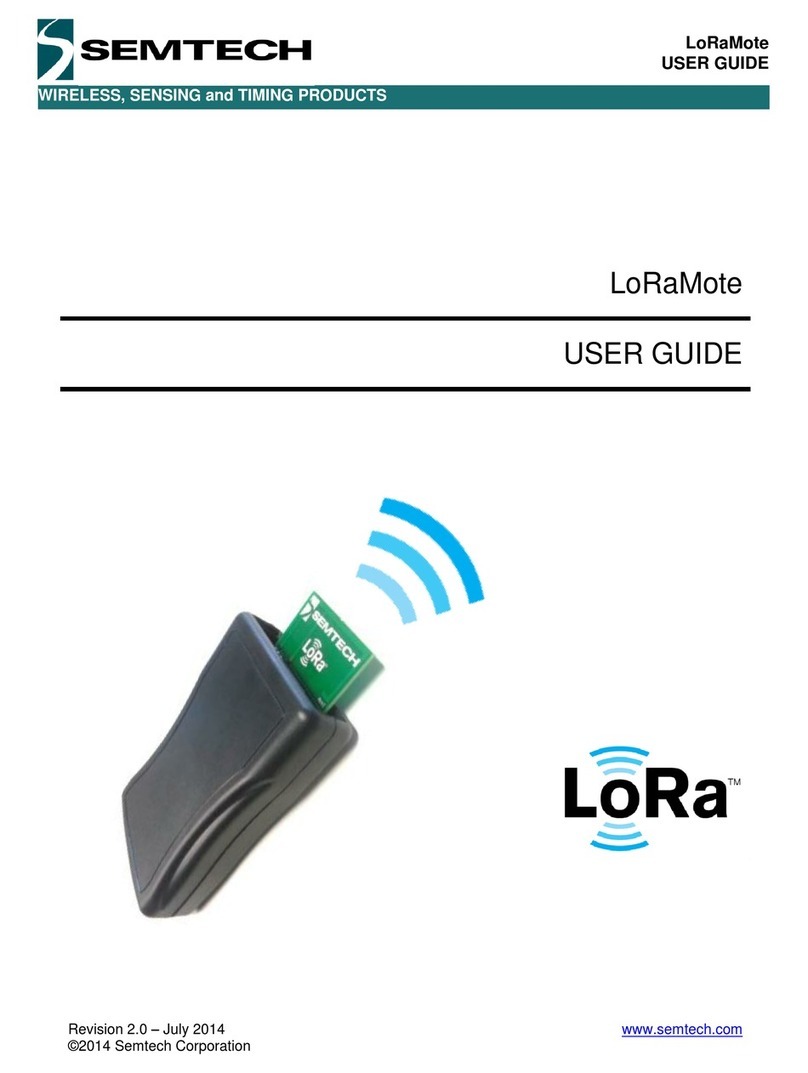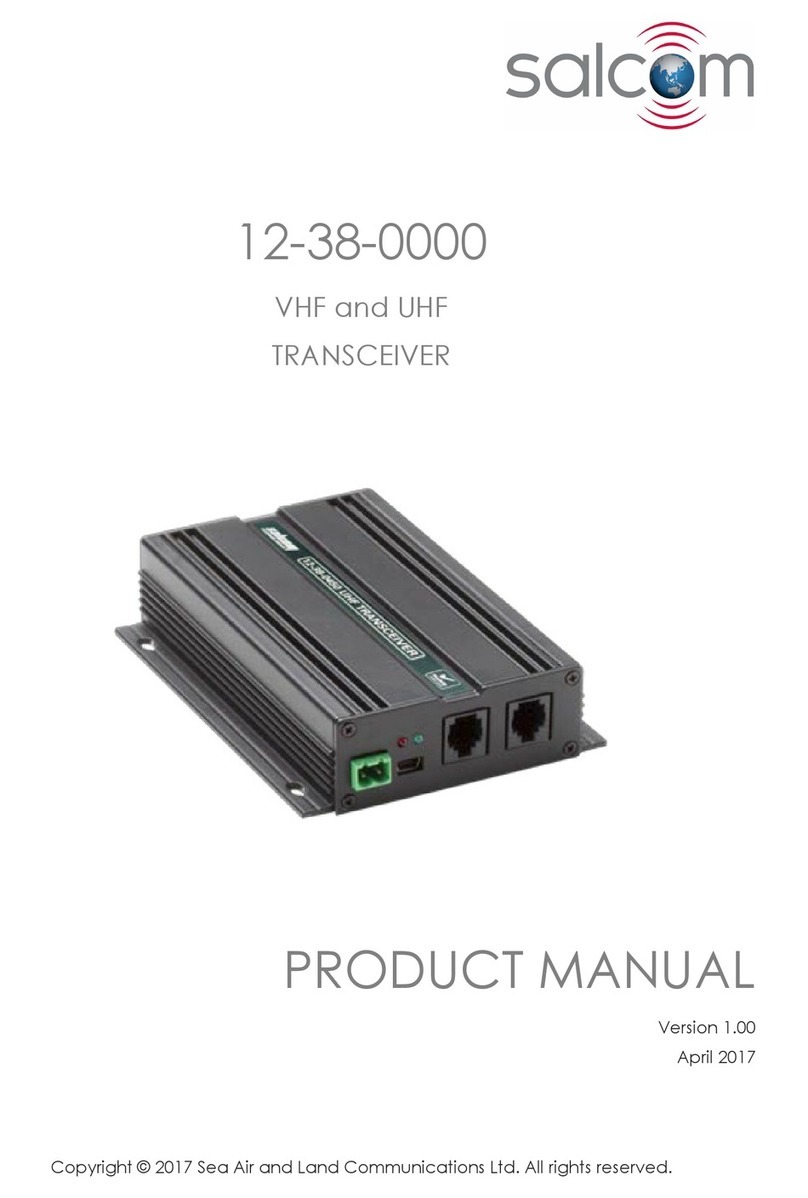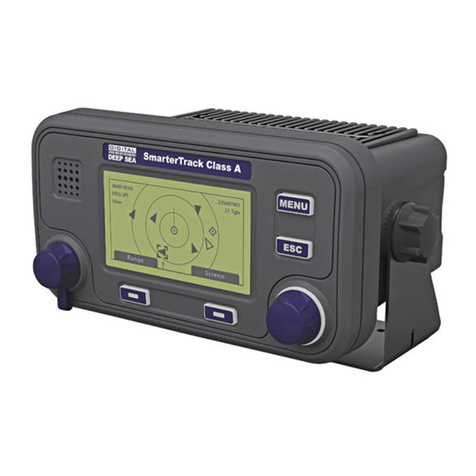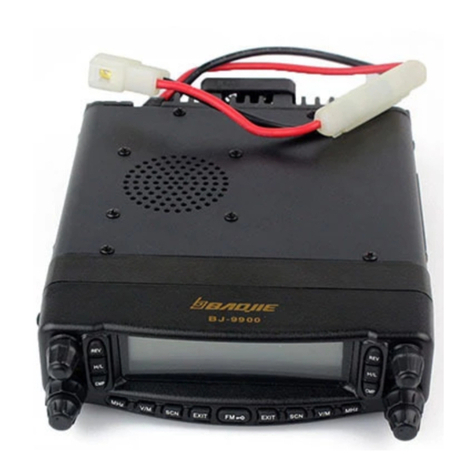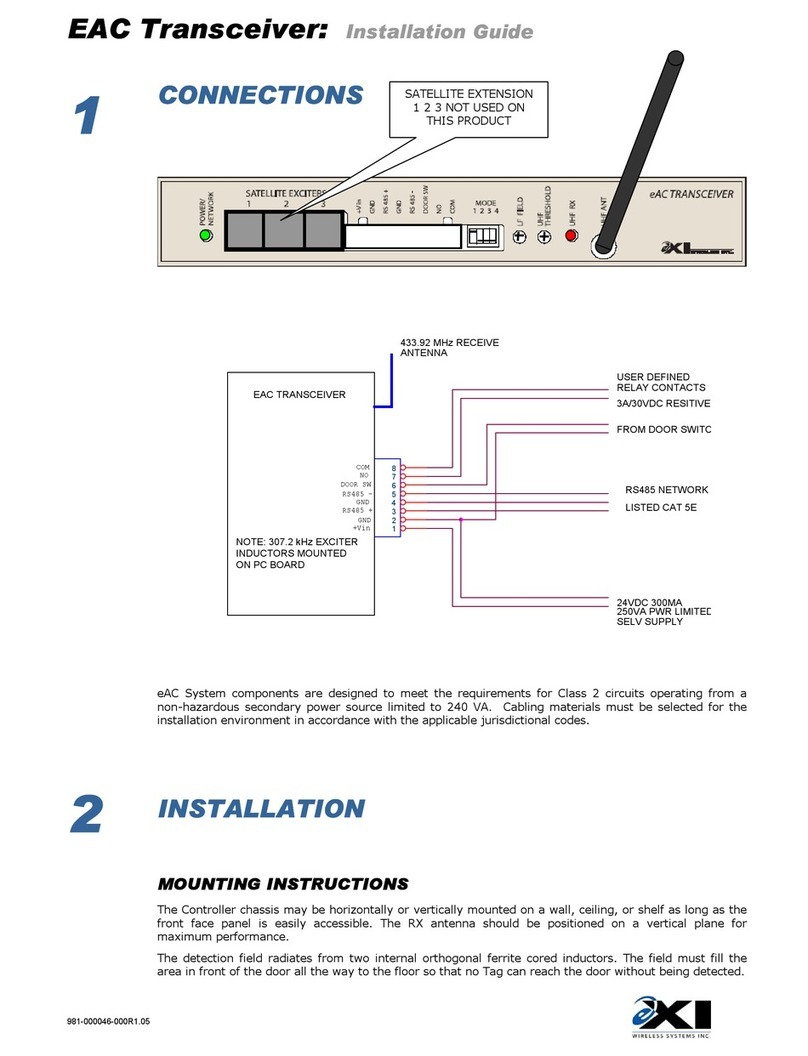Yaesu FT-736R User manual

(ik
OPERATING
MANUAL
FT-736R
YAESU
MUSEN
CO.,
LTD.
C
P
0
BOX
1500
TOKYO
JAPAN

FT-736R
MULTIMODE,
MULTIBAND
VHF
&
UHF
BASE
STATION
tr-73
60
Jitg
~k,
r'
The
FT-736R
is
a
solid-state,
frequency-synthesized
VHF
and
UHF
amateur
transceiver
incorporating
up
to
four
band
modules
covering
the
50,
144,
220,
430
and
1200
MHz
amateur
bands.
The
standard
model
provides
25
watts
RF
power
output
on
the
144
and
430
MHz
amateur
bands
in
SSB,
CW,
and
FM
modes,
with
any
two
of
the
remaining
three
bands
installable
as
options
(10
watts
output
on
the
50
and
1200
1v1Hz
bands/.
An
8
-bit
CMOS
main
microprocessor
and
4
-bit
i/o
coprocessor
provide
exceptional
digital
in
tegratiOn
and
control:
including
selectable
tuning
rates
or
mode-dependent
channelized
tuning
in
selectable
steps
for
each
mode;
and
the
widest
variety
of
advanced
scanning
methods
ever
offered.
Operating
conveniences
usually
found
only
on
HF
transceivers,
such
as
front
panel
adjustable
1F
shift
and
IF
notch,
a
noise
blanker,
all
-mode
VOX
and
three-
speed
selectable
AGC
are
inciuded.
GaAs
FET
receiver
RF
amplifiers
are
provided
in
the
430
and
1200
MHz
band
modules,
and
a
high-stability
TCXO
reference
oscillator
is
incorporated
for
all
bands
to
meet
the
stringent
demands
of
the
higher
bands.
The
innovacive
memory
system
includeS
one
hundred
genera'
purpose
memories
plus
ten
full
duplex
cross
-band
memories,
one
global
cal/
channel
memory
that
can
be
recalled
from
any
band
or
mode
and
up
co
four
band-specific
cal/
channel
memories,
all
of
which
store
mode
and
receive
and
transmit
frequencies
independently.
That
gives
you
one
hundred
and
fifteen
memories
storing
up
to
two
hundred
and
thirty
frequencies.
In
addition,
fourteen
vfos
are
provided:
two
general
purpose
plus
one
PMS
(Programmable
Memory
limit
Scanning)
on
each
band,
two special-purpose
full
duplex
vfos,
and
up
to
four
clarifier
(receiver
offset)
memories,
one
per
band.
Each
of
the
two
full
duplex
vfos
can
be
selected
so
that
its
receive
and
transmit
frequencies
and
modes
can
be
displayed
and
tuned
independently,
or
linked
to
tune
synch-
ronously
in
opposite
directions
for
satellite
operation.
You
can
retain
twelve
satellite

uplink/downlink
modes
in
the
special
vfos
and
ten
full
duplex
memories
at
all
times.
Of
course,
metering
of
either
transmitter
or
receiver
parameters
is
selectable
during
full
duplex
communications.
For
CW
operators,
the
FT-736R
offers
quick-changeover
semi
break
-in
and
includes
provisions
for
an
optional
internal
electronic
keyer
and
narrow
(600
Hz)
CW
crystal
filter.
Naturally,
with
FM
the
predominant
mode
on
the
VHF
and
UHF
bands,
the
FT-736R
includes
all
manner
of
convenient
features
for
both
FM
simplex
and
repeater
operation,
like
a
discriminator
center
tuning
meter,
special
narrow
FM
mode
(to
cut
adjacent
channel
inter
ference
in
crowded
areas)
and
Automatic
Repeater
Shift
when
tuned
to
2
-meter
repeater
subbands.
The
mode-dependent
programmable
tuning
steps
and
tracking
vfos
are
particularly
useful.
An
optional
subaudible
Tone
Squelch
Unit
can
be
programmed
from
the
front
panel,
and
a
1750
or
1800
Hz
Burst
Tone
Generator
is
installed
as
standard.
An
enhanced
CAT
(Computer
Aided
Transceiver)
System
allows
addition
and
customization
of
features
and
user-designed
controls
from
an
external
computer.
The
FT-736R
also
includes
a
t/r-switched
DC
supply
line
for
masthead
preamplifiers,
activated
from
the
front
panel,
and
digital
input
connection
directly
to
the
modulator
for
high
performance
packet
radio
tnc
interfacing
(preamps,
personal
computers
and
packet
tncs
not
supplied
by
Yaesu).
An
efficient
built
-in
switching-mode
power
supply
provides
13.8VDC
to
power
the
trans-
ceiver
from
the
AC
mains,
without
the
hearing
and
weight
of
a
heavy
power
transformer.
Inside
the
transceiver
high-grade
modular
design
ensures
easy
servicing.
Optional
add-on
accessories
include
the
TV
-736
Amateur
Television
Modulator/Demodulator
for
ATV
operation,
FIF-series
CAT
Interface
Units,
SP
-767
External
Loudspeaker,
FMP-1
AQS
Message
Processor,
and
FVS-1A
Voice
Synthesizer
and
FTS-8
CTCSS
Tone
Squelch
Unit
(both
mount
internally).
This
manual
is
organized
in
four
parts:
(1)
General
Description
and
Specifications
(2)
Controls
and
Connectors
(3)
Installation
(4)
Operation
We
recommend
reading
them
in
order;
parts
1
and
2
will
give
you
an
idea
of
the
functions
and
capabilities
of
the
transceiver,
and
part
3
will
guide
you
through
installing
and
connecting
the
transceiver,
and
any
options
you
may
have.
After
reading
these
parts
and
installing
the
transceiver
you
will
be
ready
for
part
4,
which
should
be
read
while
sitting
at
the
controls.
Note:
For
purposes
of
clarity
in
this
manual,
some
words
and
abbreviations
appear
in
lower-case
typeface
when
used
for
general
terms,
and
in
upper
-case
when
referring
to
specific
control
names.
For
example,
"vfo"
(variable
frequency
oscillator)
is
used
when
referring
to
the
-
frequency-tunable
function
in
general,
while
"VFO"
refers
specifically
to
keys
so
labelled
and
the
four
switches
under
that
label
on
the
panel.
2

SP
ECIFICATIONS
1.1
GENERAL
Operating
frequency
ranges
(MHz):
50-53.99999*
144-145.99999
(or
147.99999)
220-224.99999*
430-439.99999
(or
449.99999)
Modulation
methods:
SSB
Balanced,
filtered
carrier
FM
Variable
reactance
(±5
kHz
or
±2.5
kHz
maximum
deviation)
ATV*
low
level
carrier
Spurious
radiation:
1240
or
1260-1299.99999*
better
than
-60dB
Emission
types:
LSB/USB
(J3E
voice),
CW
(A1A)
FM
(F2D
FSK,
F3E
voice)
TV
(A3F
optional,
for
1.2
GHz*)
Carrier
suppression
(SSB):
better
than
-40dB
below
peak
output
Undesired
sideband
suppression
(SSB):
better
than
-40dB
below
peak
output
Operating
temperature
range:
-10
to
+60°C
Audio
characteristic
(SSB):
within
6dB
from
300
to
2700
Hz
Reference
oscillator
stability:
better
than
±1
ppm
(+10
to
+40°C),
and
±5
ppm
(-10
to
+60°C),
after
15
minutes
warmup
Microphone
impedance:
600
ohms
nominal
(200
ohms
to
10k)
Antenna
impedance:
1.3
RECEIVER
50
ohms,
unbalanced
Circuit
type:
Supply
voltage:
50*,
144
MHz
bands:
double-conversion
85
-
132
or
170
-
264
VAC,
50/60
Hz,
Other
bands:
triple-conversion
super
-
or
13.8
VDC
±
10%,
negative
ground
heterodyne
Power
consumption/current
req.
(Approx.):
Intermediate
frequencies:
Maximum:
250
VA
13.69
MHz
and
455
kHz,
plus
Receive:
1.5
A
47.75
MHz
on
220*,
47.43
MHz
on
430,
Transmit:
8
A
or
133.91
MHz
on
1200
MHz
band*
Dimensions
(WHD):
368
x
129
x
286
mm
Weight
9
kg
(19.8
lbs)
1.2
TRANSMITTER
Power
input
30
watts
DC
© 50
MHz*
60
watts
DC
®
144,
220*,
430
MHz
45
watts
DC
®
1.2
GHz*
Sensitivity:
SSB/CW:
better
than
-15dBu
for
12dB
S+N:N
FM:
better
than
-9dBu
for
12dB
SINAD
Squelch
sensitivity:
SSB/CW:
better
than
OdBu
FM:
better
than
-12dBu
Image
rejection:
60dB
or
better
*
requires
optional
unit
3

Selectivity
(-6/-60dB):
SSB,
CW:
CW-N
(optional):
FM:
FM
-N:
2.2/4.5
kHz
600/1200
Hz
12/25
kHz
8/19
kHz
Audio
output
power:
1.5W
into
8
ohms
with
5%
THD
Audio
output
impedance:
4
to
16
ohms
1.4
SUPPLIED
ACCESSORIES
AC
Power
Cable
Spare
Fuse
4A
(for
85-132V)
or
2A
(for
170-264V)
Preamp
Jumper
Plugs
(2
Long
Feet
(2
pcs)
Foot
Pad
(6
pcs)
FT-736R
Model
Chart
T9013285
Q0000006
Q0000003
pcs)
T9205546
R3054620
R7054630A
Version
--->
A
B1
B2
Cl
C2
Hl
H2
2m
Band
Rptr
Shift*
(MHz
144-148
144-146
144-148
144-146
144-148
144-146
144-148
FM
Ch.
Step*
(kHz)
5
12.5
12.5
12.5
12.5
5
5
Tone
Burst
(Hz)
±600
±600
±600 ±600 ±600
±600
±600
70cm
Band
Freq.
Range
(MHz)
430-450
430-440
430-440 430-440 430-440 430-440 430-440
FM
Ch.
Step*
(kHz)
12.5
12.5
12.5
12.5
12.5 12.5 12.5
Rptr
Shift*
(kHz)
±5
±7.6 ±7.6
±1.6
±1.6
±5
±5
Tone
Burst
(MHz)
1800 1750 1750 1750 1750 1750
1750
*
can
be
reset
by
operator
1.5
OPTIONS
Model
No.
E-736(DC)
FEX-736-50(A)
FEX-736-220(A)
FEX-736-1.2(A)
FEX-736-1.2(B)
FIF-232Cvan
FIF-232C
FIF-65A
FIF-MX
FMP-1
FTS-8
FVS-1A
Keyer
Unit
B
MD-1B8
MH-1B8
SP
-767
TV
-736
XF-455MC
Description
DC
Power
Cable
for
operation
from
Ext.
Supply
50
MHz
Band
Module
220
MHz
Band
Module
1.2
GHz
Band
Module
for
North
America
1.2
GHz
Band
Module
for
outside
North
America
CAT/TNC
Interface
for
Packet
Radio
&
CAT
CAT
Interface
Unit
for
serial
connection
CAT
Interface
Unit
for
Apple
II
Computer
CAT
Interface
Unit
for
MSX
Computers
AQS
Message
Processor
&
digital
message
display
37-tone
CTCSS
Subaudible
Tone
Squelch
Unit
Voice
Synthesizer
for
Aural
Frequency
Readout
Internal
Electronic
Iambic
Keyer
Desktop
Microphone
Handie
Scanning
Microphone
External
Speaker
with
Audio
Filters
Fast
Scan
Television
(ATV)
Modulator/Demodulator
600
Hz
CW
Narrow
Filter
Order
No.
D4000028
D3000529
D3000530
D3000532
D3000533
A9700
D3000307
D3000369
D3000460
A8430
D3000333
D3000371
D3000535
D1000039
D1000041
A846001
-Z
D3000534
D2000034
4

Section
2.
CONTROLS,
SWITCIIES
&
CONNECTORS
Cl
25
ca,
■
(2
-
2)
ra
n
3
Lk
1.1
n
4
n
.
liscrancriczi
•
'á
^§
MI
:j
all
a
mi
•
Lt
y
(8_,--
)®
0.)
T.
0
--
g
)
'110
1
413
0
0
CO
e
2.1
FRONT
PANEL
CONTROLS
(I)
POWER
This
button
turns
the
transceiver
on
and
off.
(2)
MOX
This
button
manually
activates
the
trans-
mitter
when
depressed.
ft
must
be
in
the
undepressed
position
for
reception,
and
for
automatie
transmitter
activation
via
the
VOX
and
CW
keying.
(3)
MIC
Jack
This
8
-pin
jack
accepts
the
microphone
plug.
Pinout
is
indicated
by
the
micro-
phone
schematic
below.
Acceptable
micro-
phone
input
impedance
is
200
ohms
to
10
kilohors,
with
600
ohms
optimum.
Pi
VP
CSY
0
(4)
PHONES
Jack
This
3
-contact
jack
accepts
either
stereo
or
monaural
headphones
with
a
2-
or
3
-
contact
plug.
When
a
plug
is
inserted
the
internat
or
external
loudspeaker
is
dis-
abled.
Impedance
is
4
to
100
ohm_
é
s.
:
Í
I
•
\
Ca
—
(5)
MIC
DRIVE
The
inner
MEC
control
sets
the
transmitter
audio
amplifier
gain
during
SSB
and
nl
transmission.
ALC
(Automatic
Level
Control)
for
SSB
and
deviation
level
for
FM
transmission
are
set
by
this
control.
The
outer
DRIVE
control
sets
the
trans-
mitter
power
output
for
all
modes.
(6)
SQL
TONE
The
inner
SQL
(squelch)
control
sets
the
signal
threshold
level
at
which
receiver
audio
is
muted.
The
outer
TONE
control
adjusts
receiver
audio
characceristics.
5

(7)
AF
RF
The
inner
AF
gain
control
adjusts
the
audio
volume
of
the
receiver
in
the
speaker
or
headphones.
The
outer
RF
gain
control
adjusts
the
gain
of
the
receiver
RF
and
Ist
IF
amplifier
on
the
50,
144
and
220
MHz
bands.
This
con-
trol
is
normally
set
fully
clockwise
for
maximum
sensitivity.
(8)
2-Position
Pushbutton
Switches
IERMSI
PAutit DIM
PROC:
enables
the
speech
processor
in
SSB
modes.
KEYER:
turns
the
optional
internal
CW
keyer
on
and
off.
BURST:
turns
the
auto-burst
feature
on
and
off
in
FM
modes.
When
on,
and
when
operating
with
repeater
shift
mode,
the
green
BURST
indicator
above
the
tuning
knob
giows,
and
an
audible
1750
Hz
or
1800
Hz
(U.S.A.
version
only)
tone
is
sent
automatically
for
t-second
whenever
the
PTT
switch
is
pressed
to
transmit.
PAUSE:
when
depressed
(ON),
the
scanner
pauses
for
five
seconds
on
any
active
channel,
and
then
resumes
scanning.
When
undepressed
(OFF),
the
scanner
stays
on
an
active
channel
until
after
the
channel
becomes
clear,
and
then
resumes
scanning.
DIM:
dims
the
brightness
of
the
display
and
meter
lamp
for
comfortable
viewing
in
the
dark.
(9)
VFO
Selector
Pushbuttons
ElEl
,
EA
1
14-1f1
r
",
El
11,01111
One
of
these
buttons
is
always
depressed:
pressing
any
other
will
disengage
whichever
one
was
pressed
previously.
RB-TA
&
RA
-TB:
engage
one
vfo
(A
or
B)
for
receiving,
and
the
other
for
transmitting
(split
frequency
operationl.
Note
that
this
is
not
the
same
as
operating
with
preselected
repeater
splits,
described
later.
A
&
B:
selects
operation
on
one
vfo
(A
or
B)
only.
(10)
Pushbuttons
with
LED
Indicators
D
LOCK
(and
red
LED):
disables
the
tuning
knob
and
CHANNEL
selector
knob,
to
prevent
inadvertent
frequency
changes.
FM
CH
(and
orange
LED):
in
FM
modes,
disables
the
main
tuning
knob
and
activates
the
detented
CHANNEL
selector
knob
for
tuning
in
user-selected
5,
10,
12.5,
15,
20, 25,
30
or
50
kHz
FM
channel
steps.
These
are
factory-preset
as
shown
in
the
chart
on
page
4.
6

SSB
CH
(and
orange
LED):
in
SSB
and
CW
modes,
disables
the
min
tuning
knob
and
activates
the
detented
CHANNEL
selector
knob
for
tuning
in
2.5
or
5
kHz
SSB
channel
steps.
NB
(with
green
LED):
activates
the
noiSe
blanker
in
SSB
and
CW
modes.
NOTCH
(with
green
LED):
activates
the
IF
notch
filter
In
SSB
and
CW
modes.
(11)
Main
Tuning
Knob
Unless
deactivated
by
the
FM
or
SSB
CH
buttons
just
described,
this
knob
adjusts
the
displayed
operating
frequency
in
10
Hz
or
100
Hz
steps
selectable
in
SSB
and
CW
modes,
or
in
100
Hz
steps
in
FM
mode
(10
Hz
if
the
CLARifier
is
on).
(12)
VDOWN
&
A
UP
Keys
When
operating
on
a
vfo,
these
keys
(above
the
Main
Tuning
Knob)
tune
the
display
frequency
in
the
same
steps
as
the
Main
Tuning
Knob,
or
in
programmable
steps
It
the
FM
CH
or
SSB
CH
button
is
pressed
(see
above).
When
operating
on
a
memory,
these
keys
select
other
prestored
memories
within
the
same
band.
Pressing
and
holding
one
of
these
keys
for
more
than
i-second
activates
the
scanner.
(13)
CHANNEL
Knob
When
operating
on
a
vfo
with
the
FM
CH
or
SSB
CH
button
depressed,
this
detented
knob
tunes
in
preprogrammed
steps
as
des-
cribed
for
chose
buttons.
When
operating
on
a
memory,
this
knob
selects
the
prestored
memories
on
all
bands.
This
differs
from
the
keys
just
described,
in
that
memory
selection
is
independent
of
the
operating
band.
This
knob
is
also
used
for
CTCSS
tone
selection
when
the
FTS-8
Tone
Squelch
Unit
is
installed.
(14)
[A1
MHz/CH
(BI
Keys
!
---
1.71iT,
alta
Cl
When
operating
on
a
vfo,
these
keys
step
the
operating
frequency
down
or
up
1
MHz,
rotating
around
the
ends
of
the
band.
When
operating
on
a
memory,
these
keys
step
the
memory
channel
number
down
or
up
(regardless
of
whether
the
memory
has
been
stored,
or
not).
Notice
that
this
is
not
the
same
as
the
CHANNEL
knob
or
the
DOWN/UP
keys
above
the
tuning
knob,
which
select
only
occupied
memories.
When
the
AQS
feature
is
acti.ve
and
the
CODE
(Digital
Code
Memory)
key
is
pressed,
these
keys
allow
selection
of
Digital
Code
Memories.
These
keys
are
also
used
for
CTCSS
zone
selection
along
with
the
CHANNEL
knob
when
the
FTS-8
option
is
installed.
During
transmission,
these
two
keys
generate
the
standard
DTMF
A
and
B
tone
pairs.
(15)
SHIFT
-ii-NOTCH
In
SSB
and
CW
modes,
the
inner
SHIFT
control
allows
the
center
of
the
receiver
IF
passband
to
be
positioned
above
below
that
of
the
received
signal,
eliminate
interference
from
signals
adjacent
frequencies
or
to
position
the
passband
on
a
range
other
than
chose
standard
for
SSB
or
CW.
Normal
setting
is
the
12
o'clock
position.
or
to
on
IF
7

The
outer
NOTCH
control
adjusts
the
fre-
quency
of
the
IF
notch
within
the
receiver
passband
when
the
NOTCH
button
is
depressed,
except
in
the
FM
mode.
(16)
na,
ENTIDI
&
T
CALL
Pushbuttons
P
■
PAPT
■
T
CALL
®E
During
reception,
FECI
activates
the
alternate
functions
(with
reverse-lettered
labels)
of
the
MODE
buttons
and
the
BAND(OFFSETI
key.
Each
of
these
functions
is
described
later,
with
"F+"
in
front
of
the
label
indicating
that
this
button
is
pressed
first.
During
transmis-
sion,
pressing
generates
the
"C"
DTMF
tone
pair.
During
reception
on
a
vfo,
ENTIDI
allows
keypad
entry
of
a
new
frequency
within
the
operating
band.
Pressing
it
once
clears
all
digits
below
1
MHz
to
zero
while
the
I
MHz
digit
blinks
(10
MHz
digit
on
the
430
and
1200
MHz
bands).
After
keying
in
a
new
frequency
on
the
display,
press
ENTIDI
again
to
shift
operation
to
the
displayed
frequency.
During
reception
on
a
memory,
ENT(DJ
allows
key
pad
entry
of
another
memory
channel
number,
in
the
same
manner
as
just
mentioned
for
frequency.
During
transmission,
pressing
ENTIDI
generates
the
"D"
DTMF
tone
pair.
In
the
FM
modes,
T
CALL
transmits
a
1750
Hz
(or
1800
Hz
in
the
U.S.
model)
burst
tone
manually,
for
as
long
as
the
button
is
pressed.
(18)
FUNCTION
Key
pad
TPTAX
•
CAIAt
0
1
11
CALL2
PAPP
■
ZWEI
All
but
one
of
these
15
keys
(the
SPEAK
key)
have
multiple
functions:
the
default
function
labelled
on
the
upper
half
of
each
key,
and
the
alternate
function
labelled
In
reverse
letters/symbols
on
the
lower
half
of
each
key.
The
default
functions
occur
when
the
key
is
pressed
while
receiving
normally,
without
any
previous
keys
having
been
pressed.
These
functions
are
des-
cribed
briefly
below,
and
their
applications
in
greater
detail
in
the
Operation
chapter.
For
alternate
key
functions,
the
top
ten
light
grey
keys
((IJ
through
(0))
are
used
for
keypad
entry
of
frequencies,
channel
numbers,
and
other
digit
entries
for
special
functions,
as
described
in
the
Operation
chapter.
Also,
while
transmitting
in
the
FM
modes,
these
ten
keys
and
the
[*1
and
(#J
keys
serve
as
a
standard
DTMF
generator:
when
one
of
these
keys
is
pressed
the
corresponding
DTMF
tone
pair
is
sent
(like
a
pushbutton
telephone).
Throughout
this
manual,
alternate
key
functions
will
be
indicated
in
square
brackets
II
following
the
default
function
name:
for
example,
the
default
function
of
the
BANDIOFFSETI
key
selects
operating
bands,
white
the
alternate
function
(to
be
referred
to
as
F+(OFFSETJ,
when
this
key
is
pressed
just
after
the
F(CJ
key
des-
cribed
above)
displays
the
offset
between
the
transmit
and
receive
frequencies.
(17)
MONITOR
VFO
When
operating
on
a
memory,
this
key
AdJusts
the
CW
sidetone
volume.
shifts
operation
to
the
vfo
(according
to
8

the
selection
of
the
VFO
switches
above
the
AF/RF
controls).
This
key
has
no
function
when
already
operating
on
a
vfo.
MR
(Memory
Recall)
This
is
the
converse
of
the
VFO
key:
when
operating
on
a
vfo,
this
key
shifts
operation
to
the
last
selected
memory
channel.
However,
when
already
operating
on
a
memory,
this
key
toggles
the
"skip-scan"
status
of
the
memory:
causing
a
small
arrowhead
to
appear
just
to
the
right
of
the
channel
number
on
the
display.
More
about
this
later.
PMS
(Programmable
Memory
Scan)
When
pressed
just
after
the
F[C]
button,
(F+PMS)
this
key
stores
the
frequencies
of
the
two
vfos
as
scanning
limits
(VFO
A
is
always
the
lower
frequency).
VFO
I
M
When
the
selected
vfo
and
memory
are
on
the
same
band,
this
key
exchanges
the
frequency
and
mode
of
each,
and
leaves
operation
on
the
vfo.
REV
(Reverse)
This
key
reverses
transmit
and
receive
frequencies
when
operating
split.
STEP
This
key
changes
the
vfo
tuning
and
scanning
steps
in
a
variety
of
ways,
depending
on
the
operating
mode
and
other
switch
settings.
Details
are
in
the
Operation
chapter.
MCK
(Memory
Check)
This
key
allows
display
of
the
contents
of
the
memory
channels
without
distur-
bing
operation.
When
this
key
is
pressed
the
MR
indicator
at
the
left
of
the
display
blinks.
The
contents
of
each
memory
channel
can
be
checked
by
the
MHz/CH
keys
or
the
CHANNEL
selector
knob.
Press
this
key
again
to
return
the
display
to
normal.
T
SET
(Tone
Setting
for
Tone
Squelch)
When
the
optional
FTS-8
CTCSS
Tone
Squelch
Unit
is
installed,
press
this
key
and
then
use
the
CHANNEL
knob
(or
MHz/CH
keys)
to
select
the
CTCSS
tone
to
be
used
for
tone
squelch
operation.
The
display
shows
the
CTCSS
tone
fre-
quency
selection
(in
Hz)
until
T
SET
is
pressed
once
more.
VFO►M
When
receiving'on
a
vfo,
this
key
copies
the
vfo
frequency,
mode
and
tone
settings
into
the
last
selected
memory.
Data
stored
previously
in
that
memory
is
overwritten,
so
be
careful
to
check
the
memory
before
pressing
this
key.
PRI
(Priority
Channel
Monitoring)
This
key
activates
periodic
monitoring
of
a
memory
channel
while
operating
on
a
vfo.
When
active,
"PRI"
is
displayed
above
the
memory
number
to
the
right
of
the
displayed
vfo
frequency,
and
every
few
seconds
reception
shifts
to
the
memory
to
check
for
activity.
Pressing
VFO
or
MR
keys
cancels
the
priority
function.
CLARECODE]
(Clarifier
[AQS
Code
Select])
The
default
function
of
this
key
toggles
the
clarifier
on
and
off.
When
on,
the
transmit
frequency
remains
fixed
while
the
main
tuning
knob
controls
only
the
receiving
frequency
(within
±
10
kHz).
The
alternate
[CODE]
function
recalls
the
AQS
digital
code
memory
when
the
AQS
function
is
on,
as
described
in
§4.20.
SPEAK
When
sizer
the
optional
FVS-1A
Voice
Synthe-
is
installed,
pressing
this
key
causes
the
operating
frequency
and
mode
to
be
read
out
by
the
synthesizer.
CALL1
When
receiving,
this
key
switches
operation
to
a
prestored
global
call
9

channel,
which
may
be
in
another
mode
or
on
another
band.
CALL2
When
receiving,
this
key
switches
operation
to
a
prestored
call
channel
on
the
same
band.
Notice
that
this
is
different
from
CALL1,
in
that
each
band
may
have
a
different
call
channel
recalled
by
CALL2.
BAND(OFFSETJ
As
already
mentioned,
the
default
BAND
function
changes
operating
bands
sequentially
with
multiple
pushes.
When
this
key
is
pressed
just
after
the
FIC1
button,
the
display
shows
the
repeater
OFFSET,
which
can
be
changed
with
the
numbered
keys,
followed
by
the
ENT[DJ
button.
(19)
AQS
Buttons
1111E8CT
CAC
AOS
These
four
buttons
control
the
AQS
features,
described
in
§4.20.
AQS
This
button
turns
the
AQS
feature
on
and
off.
When
on,
"AQS"
is
dispiayed
in
an
orange
box
at
the
right
side
of
the
display.
D
SQL
This
button
turns
system
on
and
off.
"AQS"
box
and
a
appear
at
the
right
1f
pressed
white
the
AQS
is
turned
en.
the
digital
squelch
When
on,
both
the
white
"D
SQL"
box
side
of
the
display.
AQS
feature
is
off,
CAC
This
Channel
Access
Cali
button
starts
search
for
a
clear
channel.
RESET
This
key
clears
the
AQS
system,
cancels
the
D
SQL
function,
if
active,
or
the
F[C]
or
ENTED)
states,
if
active.
(20)
MODE
Selector
Pushbuttons
~112:E1=1~1
•
L
tm
•
CSM
The
default
functions
of
these
six
momentary
buttons
select
the
operating
mode
and
receiver
IF
bandwidth:
Button
LSB
USB
FM
-N
FM
CW-N
CW
IF
BW
(6dB)
2.5
kHz
2.5
kHz
8
kHz
15
kHz
600
Hz
(w/optional
filter)
2.5
kHz
When
pressed
after
the
F[C)
key,
the
mode
buttons
select
repeater
shift
[tRPTI,
or
[-RFT],
and
tone
squetch
mode:
fENCI
(encode),
[T
SQL)
(decode
en)
and
[T
OFF)
(tone
squetch
off)
if
the
FTS-8
Tone
Squelch
Unit
is
installed.
Note
that
this
is
not
the
same
as
Digital
Tone
Squelch,
which
is
supplied
as
part
of
AQS.
(21)
Display
The
diagram
at
the
bottom
of
the
next
page
shows
the
various
segments
of
the
display.
(22)
VOX
PROC
KEPER
BURST
LEDs
These
indicators
Blow
green
when
their
a
respective
functions
are
stante:
—
10
—

VOX
=
voice-actuated
transmission
(or
semi
break
-in
CW)
PROC
=
speech
processor
on
KEYER
=
CW
keyer
on
BURST
=
auto-burst
activated
(23)
ON
AIR
and
BUSY
LEDs
The
red
ON
AIR
indicator
giows
while
transmitting.
The
green
BUSY
indicator
giows
when
the
squelch
is
open
while
re-
ceiving,
and
is
used
for
adjusting
SSB
and
FM
microphone
gain
(deviation)
when
transmitting.
(24)
METER
Selector
and
Meter
mcrAn
stpo
Ate 04
(i
irigin
1
3 3
!
P0
ut
The
meter
indicates
either
relative
recei-
ved
signal
strength
(S
scale,
top)
or
FM
discriminator
center
tuning
(DISC
scale,
bottom)
while
receiving;
and
relative
transmitter
power
output
(P0
scale),
or
transmitter
automatie
level
control
(ALC
scale)
while
transmitting.
The
METER
selector
determines
the
meter
function
according
to
operating
mode:
ALC,
PO
and
S
(the
three
leftmost
post-
dons)
select
the
meter
functions
during
satellite
(full
duplex)
operation
only.
tas
1331213
1:1
El
OM
F
M
V
FO
A
US
U
N
VFO
R
1
IS
LSO
C
Kr
N
CALL
S/PO
and
DISC/ALC
are
for
simplex
and
semi-duplex
operation.
The
S/PO
selection
shows
received
signal
strength
and
transmitter
power
output
in
all
modes.
The
DISC/ALC
selection,
while
receiving,
also
shows
S
-units
in
SSB
and
CW
modes,
but
in
the
FM
mode
the
meter
indicates
discriminator
center
tuning.
While
transmitting
with
the
DISC/ALC
selection,
the
meter
shows
ALC
(automatie
level
control
voltage)
in
SSB
and
CW
modes,
and
relative
power
output
in
PM.
(25)
PREAMP
Button
This
button
switches
+I3V
DC
(max
300
mA)
at
the
ANT
jacks
during
reception,
to
control
a
masthead
preampli
fier
(not
supplied).
(26)
Small
Controls
VOX
x
va
MAIN
OCLAV
~WIM. uPta0
r 1/
2
54
-
t
hir
‘
4,1
J‘
41
Oor
VOX
GAIN,
DELAY
&
ANTI
-TRIP
These
controls
set
the
automatie
voice-
actuated
transmit/receive
switching
in
SSB
and
FM
modes;
and
semi
break
-in
keying
in
CW
mode.
Adjustment
details
are
in
the
Operation
chapter.
I
PRI
PMS
A
SV
s
TEM
One
H
ENC
nap
Lj
Lj
otc
oma
I1

KEYER
SPEED
Note:
"SAT"
is
displayed
in
orange
when
Adjusts
the
speed
of
the
optional
this
selector
is
set
to
any
position
internal
electronic
CW
keyer,
if
installed.
except
OFF.
RX:
receiving
(downlink)
frequency
is
displayed
and
tunable,
transmit
(27)
AGC
and
SAT
Selectors
frequency
played.
is
fixed
and
not
dis-
tI
•
TX:
transmit
(uplink)
frequency
is
displayed
frequency
played.
and
tunable,
receive
is
fixed
and
not
dis-
AGC
Selects
the
desired
receiver
AGC
decay
time
in
SSB
and
CW
modes:
tast,
medium
or
slow.
SAT
(Full
Duplex
Satellite
Operatlon)
OFF:
satellite
operation
disabled
2.2
TOP
PANEL
SWITCHES
a
e
(1)
Memory
Backup
.
,
'7'
1
1
t
Accessible
through
this
hole
is
a
miniature
slide
switch
which
disconnects
the
lithium
backup
battery.
When
the
front
panel
POWER
switch
Is
off,
sliding
this
switch
to
the
left
for
30
seconds
clears
all
memories
(including
vfos),
and
resets
the
microprocessor.
NOR:
receiving
(downlink)
frequency
is
displayed,
vfos
track
together
in
same
direction
when
tuning.
REV:
receiving
(downlink)
frequency
is
displayed,
vfos
track
in
opposite
directions
when
tuning.
(2)
2
-Meter
Automatic
Repeater
Shift
Accessible
through
this
hole
is
a
miniature
slide
switch
which
disables
the
Automatic
Repeater
Shift
feature.
When
enabled,
this
feature
causes
the
transmit
frequency
to
be
automatically offset
by
a
preprogrammed
amount
(default
600
kHz)
from
the
receive
frequency
when
tuned
to
the
repeater
input
subband
of
the
144
MHz
band.
Move
this
switch
to
the
left
to
disable
this
feature.
When
disabled,
repeater
shift
can
still
be
selected
manually
with
the
+/-RPT
functions
(of
the
MODE
buttons).
—
12
—

2.3
REAR
PANEL
JACKS
&
SWITCHES
12
1
e
f
aa
)1
•
•
feb
t
er
15
IS
C
0
N
ke
0,
(1)
DC
Output
Cable
Pigtail
(4)
STBY
DIN
Jack
This
cable
provides
13.8V
DC
at
up
to
8A
from
the
internet
switching
power
supply.
Normally,
to
operate
the
transceiver
from
the
AC
malus,
this
cable
must
be
connec-
ted
to
the
I3.8VDC
jack.
GND
STBY
430MHz
STBY
50/220/1200MHz
(41‘.,
STBY
144MHz
(S)
STBY
50/220MHz
This
5
-pin
jack
provides
transmit/receive
(2)
GND
Terminal
Post
switching
Tines
for
controlling
external
transmitter
amplifiers.
Pinout
is
determined
Connect
this
terminal
to
a
good
earth
by
Band
Module
Installation
(63.7).
ground
using
heavy
braided
cable.
(3)
CAT
DIN
Jack
(5)
KEY
Jack
Cal
trb
at
rj
(I)
GND
,
0-)
BUSY
(4)
S.
OUT
NC
This
á
-inch,
3
-contact
stereo
jack
accepts
C)
13.8V
a
CW
key
or
keyer
paddles
(for
the
optional
internal
electronic
keyer),
or
your
'This
6
-pin
jack
provides
serial
I/O
external
electronic
keyer.
DO
NOT
USE
A
connections
for
external
computer
control.
2
-CONTACT
PLUG
in
this
jack.
Pinout
is
Data
rate
is
4800
bits/sec,
TTL
level.
shown
above.
Key
up
voltage
is
4.5V,
and
key
down
current
is
2
mA.
—
13
—

(6)
EXT
SPKR
(External
Speaker)
This
2
-contact
mini
phone
jack
is
for
con-
nection
of
an
external
4-
to
8
-ohm
speaker,
such
as
the
SP
-767.
(7)
PTT
Jack
This
RCA
jack
is
connected
in
parallel
with
the
MOX
switch,
and
allows
activa-
tion
of
the
transmitter
by
external
devices,
such
as
a
packet
TNC
or
a
footswitch.
Open
-circuit
voltage
is
8V
DC,
and
closed-circuit
current
is
8
mA.
(8)
DATA
IN/OUT
Jack
This
3
-contact
mini
stereo
jack
allows
direct
connection
to
the
FM
receiver
demodulator
and
FM
transmitter
modulator,
for
digital
terminal
equipment
such
as
a
packet
radio
TNC.
No
pre-
or
de-emphasis
is
added
to
the
signals
at
this
jack.
Input
impedance
(ring
contact)
is
600
ohms
(for
FM
mode
only)
and
input
signal
level
should
be
30
mVrms.
Output
(tip
contact)
level
is
200
mVrms
maximum
at
10
kilohms.
(9)
13.8VDC
Socket
DATA
IN
DATA
OUT
GND
For
AC
operation,
connect
the
DC
supply
cable
pigtail
(1)
to
this
jack.
To
operate
the
transceiver
from
an
external
DC
source,
connect
your
13.8V
DC
supply
here.
The
supply
must
be
capable
of
at
least
8
Amperes
continuous
load.
(10)
FUSE
Holder
For
100
-
117
VAC
operation,
install
a
4A
fuse
here.
For
200
-
234
VAC
operation
install
a
2A
fuse.
(11)
AC
Jack
After
ensuring
that
the
installed
fuse
has
the
correct
rating
for
the
AC
voltage
to
be
used,
connect
the
mating
end
of
the
supplied
AC
cable
to
this
3
-pin
jack.
(12)
144
MHz
Coaxial
Jack
This
type
'M'
(S0-239)
jack
is
for
connec-
tion
of
your
antenna
for
the
2
-meter
band
or
linear
amplifier
input.
Optimum
impedance
is
50
ohms,
unbalanced.
(13)
430
MHz
Coaxial
Jack
This
type
'N'
jack
is
for
connection
of
your
antenna
for
the
70
-centimeter
band,
or
linear
amplifier
input.
Optimum
impedance
is
50
ohms,
unbalanced.
(14)
50
MHz
or
220
MHz
Coaxial
Jack
(Optional)
This
type
'M'
(S0-239)
jack
is
present
only
if
the
optional
50
MHz
or
220
MHz
band
modules
are
installed.
Connect
your
antenna
for
the
6
-meter
or
14
-meter
band
(respectively),
or
linear
amplifier
input.
Optimum
impedance
is
50
ohms
unbalanced.
(15)
50/220
MHz
or
1.2
GHz
Coaxial
Jack
(Optional)
If
the
1.2
GHz
band
module
is
installed,
it
must
be
in
this
location.
Otherwise
the
50
or
220
MHz
band
modules
may
be
installed
here.
The
1.2
GHz
module
has
a
type
'N'
jack,
and
the
50/220
MHz
modules
have
a
type
'M'
(S0-239)
jack.
Connect
your
antenna
or
linear
amplifier
for
the
appropriate
band.
Optimum
impedance
is
50
ohms,
unbalanced.

Section
3.
INSTALLA
l'ION
3.1
Preliminary
Inspection
Inspect
the
transceiver
thoroughly
immediately
upon
opening
the
packing
carton.
Check
to
see
that
all
controls
and
switches
work
freely,
and
inspect
the
outside
of
the
cabinet
for
any
signs
of
damage.
If
any
damage
is
found
document
it
completely,
and
contact
the
chipping
company
(or
dealer,
if
you
purchased
it
over
the
counter)
right
away.
Save
the
packing
materials
for
possible
use
at
a
later
date.
1f
you
have
purchased
optional
band
modules
or
other
internal
options
that
are
not
yet
installed,
see
63.5
to
Install
them
before
proceeding.
3.2
Power
Connection
Before
connecting
power,
if
using
AC,
check
the
AC
voltage
label
on
the
rear
panel,
to
make
sure
that
ic
matches
your
local
line
voltage.
The
switching
supply
in
the
FT-736R
may
be
wired
for
operation
from
85
to
132
VAC
or
170
to
264
VAC.
If
your
mains
voltage
is
not
within
the
range
of
the
label,
the
power
supply
range
jumper
must
be
relocated
as
shown
below,
and
the
fuse
must
be
changed.
Make
sure
to
change
the
label
if
you
change
the
power
supply
range.
'WI
IE
,
I.
gl•
.11
,
•••
e
'gr
mr
"do
I•P
••••
ittfrib•iii••••••••••••
‘•
• •
di
• • • • • • • • • • • • •
',
d
• • • • • • • • • • f • • • • I
•
fl
• • • • • • •
••• •••
•
1»
g'
• •
ás
^'
• • • •
••*
• • •
•
4 •
m
• • • • • • •
1
9,
C
•
Y
• •
lb*
• •
'b
• • • •
o •
S
4
NOTE:
if
you
relocate
the
power
supply
jumper
you
must
change
the
fuse
in
the
fuse
holder.
The
lower
voltage
range
re-
quires
a
4A
fuse,
and
the
higher
voltage
range
requires
a
2A
fuse.
CAUTION
PERMANENT
DAMACE
WILL
RESULT
IF
IMPROPER
SUPPLY
VOLTAGE
IS
APPLIED
TO
THE
TRANSCEIVER.
YOUR
WARRANTY
DOES
NOT
COVER
DAMAGE
CAUSED
BY
IMPROPER
SUPPLY
VOLTAGE
OR
USE
OF
AN
IMPROPER
FUSE.
After
making
certain
the
AC
label
matches
your
line
voltage,
and
the
correct
fuse
is
installed
in
the
fuse
holder,
connect
the
DC
output
cable
pigtail
to
the
I3.8VDC
socket,
and
then
connect
the
AC
power
cord
to
the
3
-pin
AC
jack
on
the
rear
panel
(see
the
photo
below).
Do
not
connect
the
other
end
of
the
power
oord
to
the
walt
outlet
until
all
other
trans-
ceiver
interconnections
have
been
made.
1f
using
an
external
DC
supply,
it
must
be
capable
of
8
Amperes
continuous
load.
Connect
it
to
the
13.8VDC
socket
on
the
rear
panel,
ensuring
proper
polarity.
S
•
S•Ct...11-z
i
AC
power
cord
4-
•
•
—
15
—

3.3
Transceiver
Location
and
Grounding
A
primary
consideration
in
setting
up
the
FT-7
36R
is
providing
for
adequate
ventilation
around
the
top
and
rear
of
the
cabinet.
Do
not
place
the
transceiver
on
top
of
another
heat-generating
device
such
as
a
linear
amplifier,
and
do
not
place
equipment,
books
or
papers
on
top
of
the
transceiver.
Avoid
heating
vents
and
window
locations
that
could
expose
the
transceiver
to
excessive
direct
sunlight,
especially
in
hot
climates.
Connect
the
GND
terminal
on
the
rear
panel
to
a
good
earth
ground,
using
a
heavy
braided
cable
of
the
shortest
length
possible.
All
other
station
equipment
should
be
connected
to
the
same
grounding
cable,
as
close
together
as
practical.
If
you
use
a
computer
with
or
near
the
FT-736R,
you
may
need
to
experiment
with
ground
wiring
to
suppress
computer
noise
in
the
receiver.
3.4
Antenna
Considerations
The
type
of
antenna
to
use
depends
on
the
purpose
of
your
communications.
For
example,
antennas
for
FM
operation
are
generally
vertically
polarized,
while
antennas
for
CW
and
SSB
are
horizontally
polarized
for
terrestrial
communications,
and
circularly
polarized
for
satellite
communications.
You
may,
of
course,
use
any
of
these
types
interchangeably,
but
performance
will
be
diminished
if
you
do
not
follow
these
customary
practices.
Any
antennas
that
you
use
should
be
designed
to
provide
50
ohms
impedance
on
the
operating
band.
For
specific
information,
consult
your
favorite
amateur
radio
handbook,
and
talk
to
your
Yaesu
dealer.
3.5
Installation
of
Options
3.5.1
Band
Module
Installation
The
FT-736R
is
supplied
with
the
144
MHz
and
430
MHz
band
modules
already
instal-
led
in
the
two
upper
compartments.
Up
to
two
additional
band
modules
may
also
be
installed,
in
the
lower
compartments.
Note
in
the
next
diagram
that
the
1.2
GHz
module
may
be
installed
only
in
the
lower
left
corner
(when
viewed
from
the
rear).
The
50
and
220
MHz
modules
may
be
in
-
stalled
in
either
lower
compartment.
430
MHz
144
MHz
50/220MHz/1.2GHz
50/220
MHz
(1)
Remove
all
connections
from
the
jacks
on
the
rear
panel,
and
then
remove
the
two
screws
in
the
carrying
handle
and
the
eight
screws
affixing
the
top
and
bottom
covers.
Remove
the
handle
and
covers,
and
place
the
transceiver
upside-down
on
the
workbench.
(2)
Locate
the
gray
rubber
thermal
pad
supplied
with
the
Band
Module,
and
the
four
machine
screws.
After
confirming
the
correct
location
for
the
Module,
insert
the
machine
screws
from
the
rear
through
the
four
holes
in
the
heatsink
and
then
through
the
holes
in
the
thermal
sheet.
—
16
—

(3)
Carefully
slide
the
Band
Module
into
place
so
that
the
mounting
feet
on
the
Module
fit
into
their
slots
in
the
chassis.
(4)
Tighten
the
four
machine
screws,
and
Install
one
self-tapping
screw
(for
50
or
220
MHz
modules:
two
for
the
1.2
GHz
module)
through
the
hotels)
near
the
front
of
the
module
into
the
chassis.
(5)
Loosen
the
two
front
panel
mounting
screws
on
each
side,
and
fold
the
front
panel
upwards.
•
•
(6)
Connect
the
single
red
wire
to
either
of
the
terminals
on
the
terminal
block.
(7)
Insta!!
the
13
-pin
plug
into
J5010
er
J5011,
and
the
10
-pin
plug
into
J1005
or
J1006.
Now
maks
a
note
of
winch
band
modules
are
connected
to
J5010
and
J501
t.
You
wilt
need
this
information
when
connecting
a
masthead
preamp
(63.6)
or
an
external
power
amplifier
(§3.7).
C
zikzaZ,b1,..„
-
go
(8)
1f
you
are
Installing
other
options,
proceed
to
the
appropriate
sections
below.
Otherwise,
fold
the
front
panel
back
into
place,
tighten
its
screws,
and
replace
the
covers
and
carrying
handle.
3.5.2
Keyer
Unit
Installation
(1)
Remove
the
eight
screws
affixing
the
top
cover,
and
remove
the
cover.
(2)
Locate
8
-pin
connector
P4001
on
the
TX
Board.
TX
Board
P400
oir
I*
••
_
=k
ir
,
tille
(3)
Cut
the
tv.
,
isted
jumper
wire
near
P4001.
1
1
(4)
Insert
the
Keyer
Unit
into
P4001.
1,
ihit
I
ir
-
liSikt '1
t
I.
at %
aalt.*
irs
c
rnr4y..t
11
(5)
Replace
the
top
cover
and
its
eight
screws,
unless
instelling
other
options.
-
17
—

3.5.3
CW
Narrow
Filter
Installation
3.5.4
Tone
Squelch
Unit
Installation
(1)
Remove
all
interconnections
from
the
rear
panel,
and
then
remove
the
two
screws
in
the
carrying
handle
and
eight
screws
affixing
the
covers.
Remove
the
handle
and
covers,
and
place
the
transceiver
left
side
up
on
the
workbench.
(2)
Remove
the
six
screws
affixing
the
RX
IF
Unit
at
the
left
side
of
the
chassis,
and
carefully
fold
the
board
away
to
allow
access
to
the
solder
side.
i.
jumper
plug
sr*
CW
filter
•
(3)
Insert
the
four
filter
leads
into
their
holes,
and
solder
them
into
place
(polarity
is
not
important).
(4)
Move
the
jumper
plug
indicated
betow
from
the
WI[de]
to
the
NA(rrow]
pins.
SS8
ham
(5)
1.•M•
04
5911
11•••
cw„
.
Replace
the
RX
1F
Unit
and
its
six
screws
Ifusing
care
not
to
pinch
any
wires).
If
instelling
other
options,
proceed
to
the
next
paragraph.
Otherwise,
replace
the
covers
and
carrying
handle,
and
their
screws.
(1)
Perform
step
(1)
of
the
CW
Narrow
Filter
Installation,
at
right.
Set
the
transceiver
top
side
up.
(2)
Loosen
the
two
front
panel
mounting
screws
on
each
side,
and
fold
the
front
panel
down.
11=
0
L-
• •
(3)
Inside
the
front
panel,
locate
8
-pin
jack
J1019
and
6
-pin
jack
JI020.
Remove
the
jumper
wire
in
JI020,
and
instel!
the
FTS-8
in
these
two
jacks.
\*1
[1—.2
NOTE:
if
the
FTS-8
is
removed
a
jumper
must
be
reinstalled
between
Ons
4
and
5
of
JI020.
The
output
level
of
the
Tone
Squelch
Unit
bas
been
preset
at
the
factory,
but
may
be
realigned
by
adjusting
the
trimmer
potentiometer
on
the
FTS-8
(as
described
in
the
FT-736R
Technical
Supplement).
(4)
If
you
are
Installing
the
FVS-IA
pro-
ceed
to
step
(3)
of
the
next
section.
Otherwise,
fold
the
front
panel
back
up,
tighten
its
screws,
and
replace
the
covers
and
carrying
handle.
—
18
—

3.5.5
FVS-IA
Voice
Synthesizer
(I)
Perform
step
(I)
of
the
Filter
Instailation
on
page
the
transceiver
top
side
up.
Installation
CW
Narrow
18,
and
set
(2)
Perform
step
(2)
of
the
Tone
Squelch
Unit
Installation
on
page
18.
(3)
Inside
of
the
front
panel
behind
the
keypad,
locate
the
unconnected
10
-pin
jack,
and
connect
the
FVS-IA
here.
itk
Display
Unit
--10-pin
Connector
(4)
Set
the
JAIpanesel/ENklish]
switch
on
the
FVS-1A
to
the
desired
position,
and
then
affix
the
FVS-1A
board
into
place
using
the
double-sided
adhesive
tape
on
the
flat
surface
of
the
FVS-1A
IC.
qui
*
411
•
t e
4.
* 0 •
4.
j*O
*
•
-7
•
ie
•
de.
:!
--
0
0
0
(5)
Fold
the
front
panel
back
into
place,
tighten
its
screws,
and
replace
the
covers
and
carrying
handle.
3.6
Preamp
Jumper
Installation
lf
you
plan
to
use
a
masthead
preamplifier
(not
supplied),
you
wilt
meed
to
install
one
of
the
supplied
jumper
plugs
to
provide
12V
DC
(at
up
to
300mA)
across
the
antenne
jack
of
the
corresponding
band
module.
Note
that
the
proper
place
to
install
the
jumper
for
50
MHz,
220
MHz
or
1.2
GHz
depends
on
which
AF
Unit
jacks
(nos.
J5010
or
J5011)
were
used
in
the
Band
Module
Installation
(63.5.1):
Install
a
jumper
plug
on
35016
to
activate
a
preamp
for
the
Band
Module
connected
to
jack
J5010.
Instelt
a
jumper
plug
on
J5017
to
activate
a
preamp
for
the
Band
Module
connected
to
jack
J5011.
Since
the
144
and
430
MHz
modules
are
already
installed,
just
put
a
Jumper
plug
on
J5018
to
activate
a
144
MHz
preamp,
or
on
JS019
to
activate
a
430
MI
-1z
preamp.
The
diagram
on
the
next
page
shows
the
preamp
supply
switching
circuitry.
J5011
J5010J5010
i.
tff
0
aces
,,
,
>
00
oe
1
10
11
,
Ik
—
19
—
Other manuals for FT-736R
4
Other Yaesu Transceiver manuals

Yaesu
Yaesu FTDX10 User manual

Yaesu
Yaesu FT-817 - User manual

Yaesu
Yaesu FT-767GX User manual
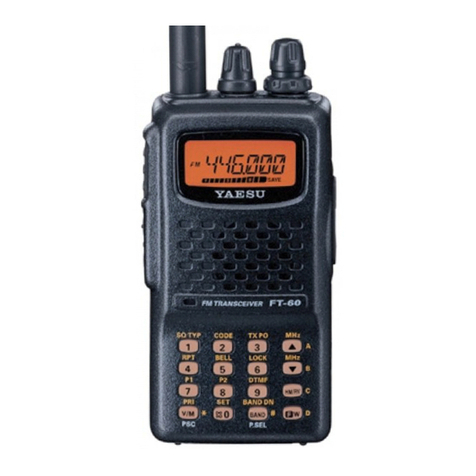
Yaesu
Yaesu FT-60R Manual

Yaesu
Yaesu FT-757GX II User manual

Yaesu
Yaesu FT-23R MKII User manual

Yaesu
Yaesu FTM-350 - APRS User manual
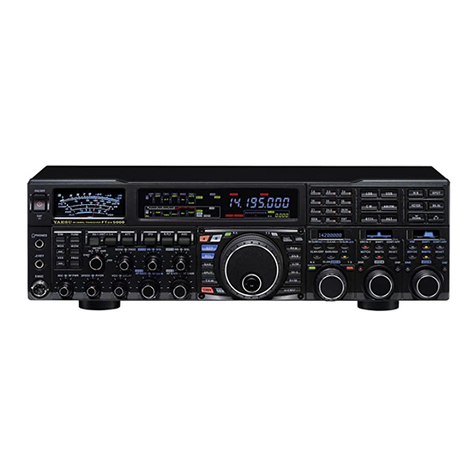
Yaesu
Yaesu FTdx5000 Series Manual

Yaesu
Yaesu MARK-V FT-100MP User manual

Yaesu
Yaesu FT-2500M User manual
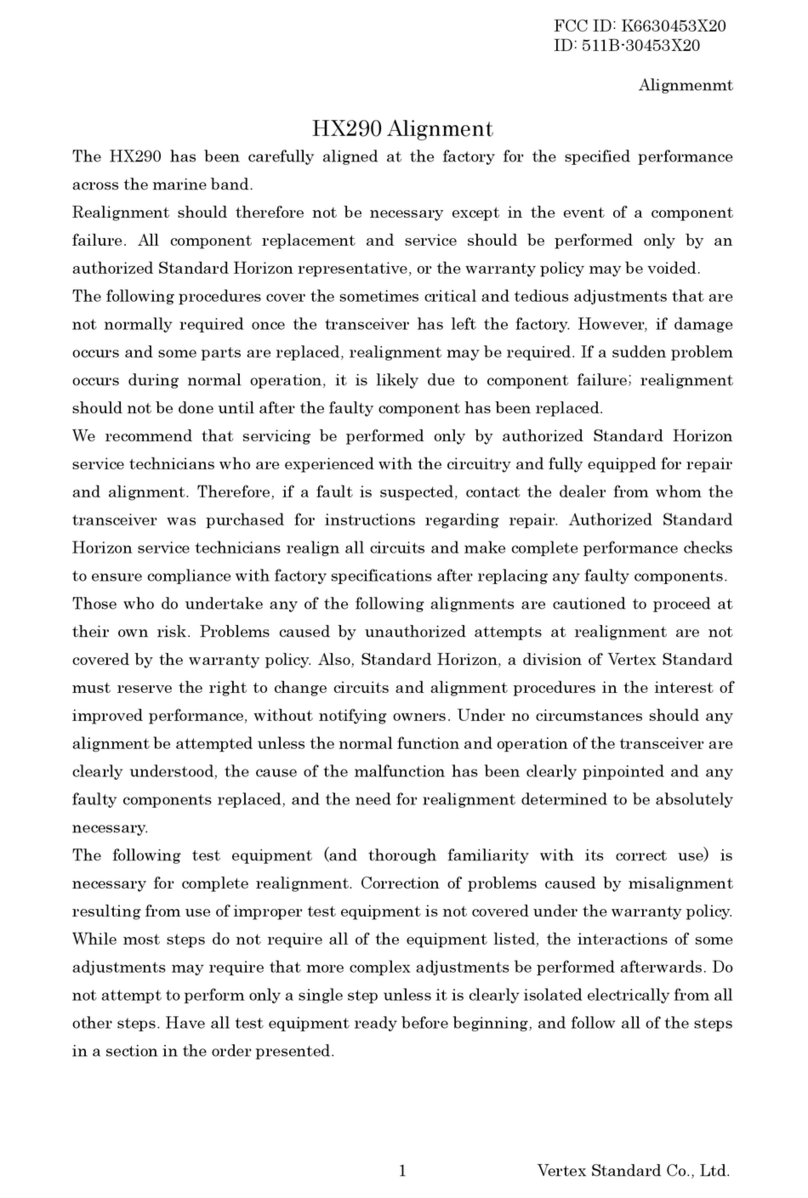
Yaesu
Yaesu HX290 User manual
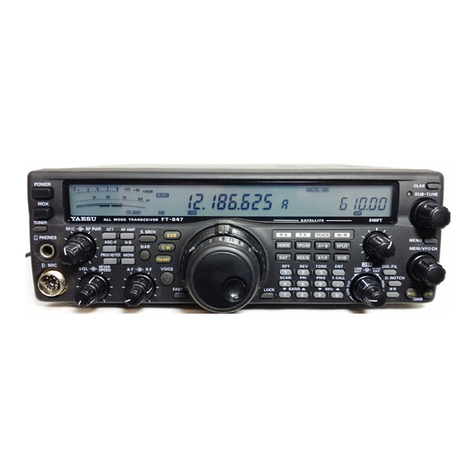
Yaesu
Yaesu FT-847 Manual

Yaesu
Yaesu FTdx5000 Series User manual
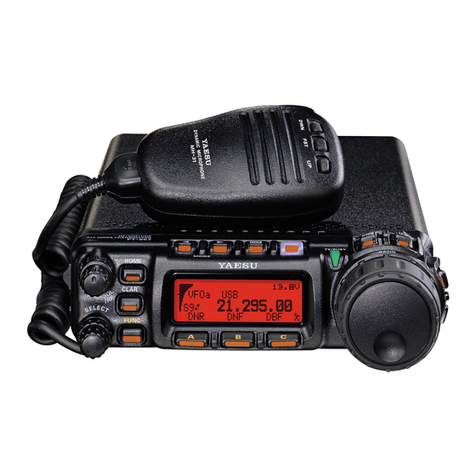
Yaesu
Yaesu FT-857D User manual

Yaesu
Yaesu FT-901DM Manual

Yaesu
Yaesu FT-5100 Manual

Yaesu
Yaesu FT-212RH User manual

Yaesu
Yaesu FT-223 Instruction Manual

Yaesu
Yaesu FT-2000 - MENU MODE LIST User manual

Yaesu
Yaesu FTM-300DR User manual

